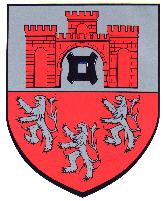Steinsel (Luxembourg): Difference between revisions
Knorrepoes (talk | contribs) m (Text replace - "'''Origin/meaning :'''<br/>" to "====Origin/meaning====") |
Knorrepoes (talk | contribs) m (Text replace - "[[Literature" to "{{media}} [[Literature") |
||
| Line 15: | Line 15: | ||
The village Heinsdorf was first mentioned as a separate entity in 1314, with Henri de Stein mentioned as first Lord of Heisdorf. His arms are shown in the lower part of the arms. | The village Heinsdorf was first mentioned as a separate entity in 1314, with Henri de Stein mentioned as first Lord of Heisdorf. His arms are shown in the lower part of the arms. | ||
{{media}} | |||
[[Literature]] : Loutsch, J-C. et al.; Armorial communal du Grand-Duché de Luxembourg, Fisch, Luxembourg, 1989, 331 p. | [[Literature]] : Loutsch, J-C. et al.; Armorial communal du Grand-Duché de Luxembourg, Fisch, Luxembourg, 1989, 331 p. | ||
Revision as of 06:18, 9 July 2014
| Heraldry of the World Civic heraldry of Luxembourg |
STEINSEL
Origin/meaning
The arms were granted on July 15, 1983.
Before the Napoleonic time, Steinsel and Mullendorf formed a community, owned by the Grand-Dukes of Luxembourg and ruled by a cartaker appointed by the Dukes. The arms of such servants (prévost) were the lion of Luxembourg, with two castles, on either side of the lion one. The upper part of the arms show such a castle. In the gate of the castl ethere is a water-mill wheel, which is a canting symbol for Mullendorf (from Mühlendorf, or mill-village).
The village Heinsdorf was first mentioned as a separate entity in 1314, with Henri de Stein mentioned as first Lord of Heisdorf. His arms are shown in the lower part of the arms.
Contact and Support
Partners:
Your logo here ?
Contact us
© since 1995, Heraldry of the World, Ralf Hartemink 
Index of the site
Literature : Loutsch, J-C. et al.; Armorial communal du Grand-Duché de Luxembourg, Fisch, Luxembourg, 1989, 331 p.











